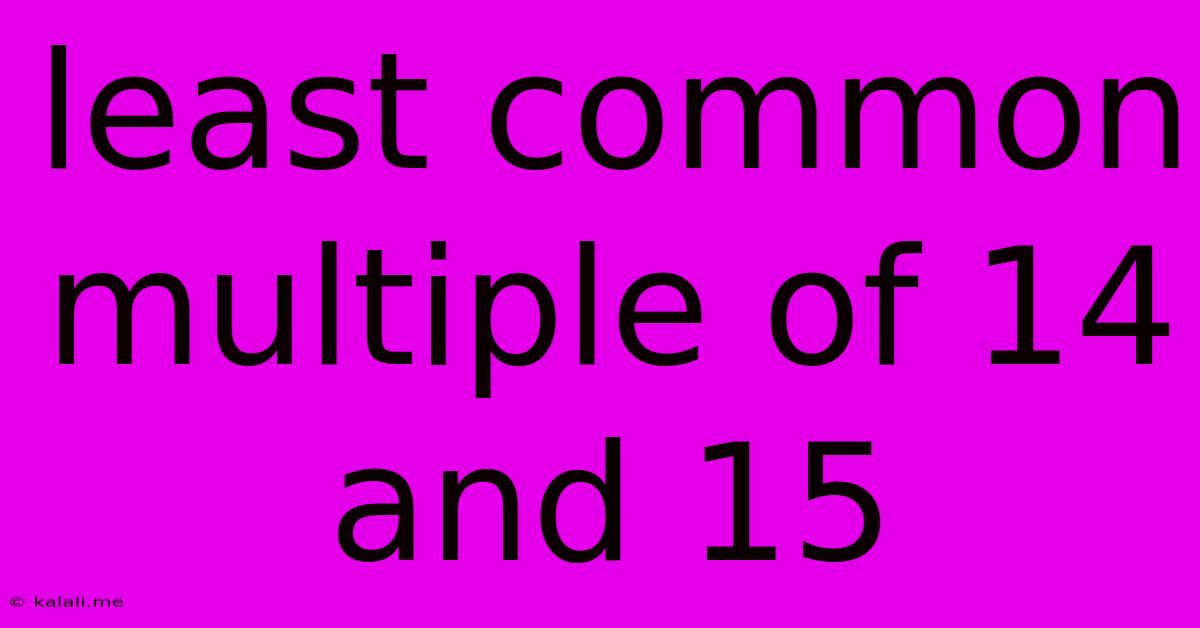Least Common Multiple Of 14 And 15
Kalali
May 08, 2025 · 3 min read

Table of Contents
Finding the Least Common Multiple (LCM) of 14 and 15: A Step-by-Step Guide
Finding the least common multiple (LCM) is a fundamental concept in mathematics, particularly useful in various fields like scheduling, music theory, and even computer programming. This article provides a clear and comprehensive guide on how to calculate the LCM of 14 and 15, explaining the methods involved and offering insights into the underlying mathematical principles. Understanding LCMs is crucial for solving various mathematical problems efficiently. This guide will help you master this skill.
What is the Least Common Multiple (LCM)?
The least common multiple (LCM) of two or more integers is the smallest positive integer that is divisible by all the integers. In simpler terms, it's the smallest number that both numbers can divide into evenly. For instance, the LCM of 2 and 3 is 6 because 6 is the smallest number divisible by both 2 and 3.
Methods for Finding the LCM of 14 and 15
There are primarily two effective methods to determine the LCM of 14 and 15:
1. Listing Multiples Method
This method involves listing the multiples of each number until you find the smallest common multiple.
- Multiples of 14: 14, 28, 42, 56, 70, 84, 98, 112, 126, 140, 154, ...
- Multiples of 15: 15, 30, 45, 60, 75, 90, 105, 120, 135, 150, 165, 180, 195, 210...
By comparing the lists, we find that the smallest common multiple is 210. Therefore, the LCM of 14 and 15 is 210. While straightforward, this method becomes less efficient when dealing with larger numbers.
2. Prime Factorization Method
This method is generally more efficient, especially for larger numbers. It involves breaking down each number into its prime factors.
- Prime factorization of 14: 2 x 7
- Prime factorization of 15: 3 x 5
To find the LCM, we take the highest power of each prime factor present in either factorization and multiply them together:
2 x 3 x 5 x 7 = 210
Therefore, the LCM of 14 and 15, using the prime factorization method, is 210. This method offers a more systematic and efficient approach, particularly useful when calculating the LCM of larger numbers or multiple numbers.
Understanding the Significance of the LCM
The LCM has practical applications in various areas. For example:
- Scheduling: Determining when two events will occur simultaneously. Imagine two buses arriving at a station at different intervals. The LCM helps calculate when they'll arrive together.
- Fractions: Finding a common denominator when adding or subtracting fractions.
- Music Theory: Calculating the rhythmic patterns and harmonies.
Conclusion:
Both the listing multiples method and the prime factorization method are viable options for calculating the LCM. However, the prime factorization method offers a more efficient and systematic approach, particularly for larger numbers. Understanding the concept of LCM and the various methods to calculate it is essential for various mathematical applications. The LCM of 14 and 15 is definitively 210. Remember to choose the method most suitable for the numbers you are working with.
Latest Posts
Latest Posts
-
Least Common Multiple 6 And 12
May 09, 2025
-
Difference Between Sex Linked And Autosomal
May 09, 2025
-
What Specialized Cells Do Cnidarians Use For Protection
May 09, 2025
-
Why Do Reptiles Have Pale Tongues
May 09, 2025
-
How Many Square Feet Are In One Square Yard
May 09, 2025
Related Post
Thank you for visiting our website which covers about Least Common Multiple Of 14 And 15 . We hope the information provided has been useful to you. Feel free to contact us if you have any questions or need further assistance. See you next time and don't miss to bookmark.